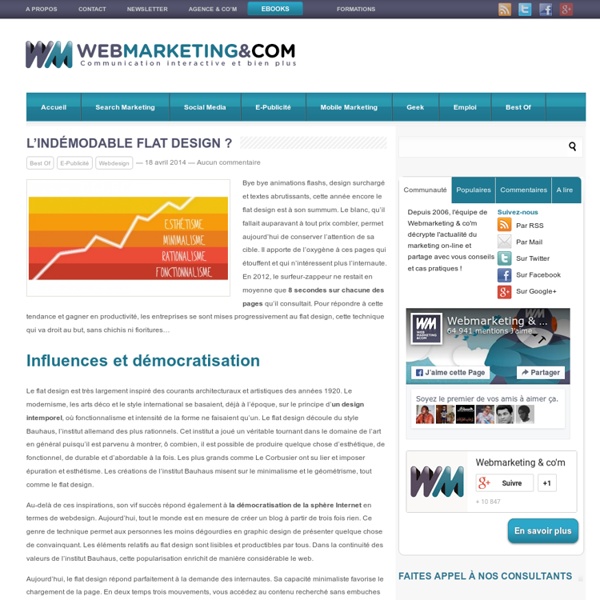L’indémodable flat design

20 Design Rules You Should Never Break
Just like with any profession or discipline, design comes with some rules. While breaking design rules is allowed and even (in some circumstances) encouraged, it’s important to at least be aware of the rules you are breaking so you can break them the right way. From typography to layout, right through to colour and special effects, this list runs through a few basic rules, tips, tricks and guides to some common errors and how to banish them from your design. 01. Somebody once said that if you truly hate someone, teach them how to recognise bad kerning. Kerning is the adjustment of space between characters. While we’ll run over a few typographical mistakes in this list, be sure to also check out these 20 other typographic mistakes that you should avoid at all costs. 02. I’m sure I’ve said this a million times, but the primary purpose of design is communication, so it makes sense that the readability and legibility of your type is a top priority. So, what hinders readability and legibility?
The (Sometimes Hidden) Meaning of Shapes
The shapes of objects in your design may be sending a message to users that you aren’t even aware of. Whether you put an image inside a square or circle or triangle can have an impact on what people think about that image. Sometimes a shape is more than just a group of connected lines. The use of shapes can be obvious or subtle and appear within images or as elements in a design. Types of Shapes When thinking about shapes, there are three categories to consider: Geometric, organic and abstract. Geometric shapes are the basics that you learn about in elementary school. Organic shapes are those that often represent things found in nature. Abstract shapes are super-simple versions of common elements or forms. Squares and Rectangles Squares and rectangles are the default shape for most projects for a reason. On the flip side, because this shape is so common it can sometimes be seen as boring or plain. Squares are the least common use of this four-sided shape. Circles Triangles Crosses Spirals
10 Popular Trends in Newsletter Signup Forms
The art of the newsletter signup form is one that you may interact with more often than you think. Email marketing is one of the best and most-used ways that brands interact with customers. And it all starts with a simple sign up. From pop ups to full-page forms, newsletter signups are everywhere. 1. Your signup form should do just one thing – ask for a user’s email address. This two-step process will give you more flexibility in the design and help create a reason to engage with users again a few days after the initial contact. 2. What’s actually going to make someone give you their email address? This gift can be in the form of a freebie from your site, a physical gift you send them (stickers are a popular option) or excellent content that users will want to get in their inbox. 3. More and more sites are displaying signup stats near or with the signup form and it’s a great idea. Who else or how many other people are signed up? 4. 5. The form needs to be simple. 6. 7. 8. 9. 10.
5 Big Mobile Design Trends of 2015
The mobile Internet is ramping faster than desktop Internet did, and we believe more users may connect to the Internet via mobile devices than desktop PCs within five years. Morgan Stanley – December 2009 Photo: Rosenfeld Media I remember the predictions like this back in the late 2000’s. In fact, Comscore had us passing the ‘tipping point’ early last year. So, it follows that if mobile is now the majority viewing device, ‘designing for mobile’ is now just plain ‘designing’ now. With that in mind, today we are running down five big trends that you can expect to see through mobile design in 2015. Subtle Color Palettes While it is quite likely that you will be seeing bigger and bolder colors used in web design, the exact opposite will be occurring as far as mobile apps are concerned. Simple, subtle color schemes will now take the place of bold and flashy palettes. Don’t let the talk of subtle color palettes fool you, there will be plenty of contrast to be had. Animated Elements More Scrolling
Related:
Related:



